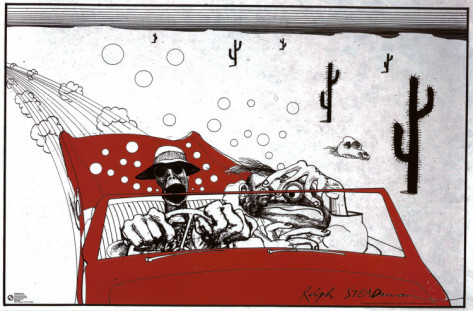Fear and Loathing in Las Vegas*
Hunter Thompson
1. There are books (and movies and music and…) that ingrain themselves into your conscious so hard that you forget just how much they influence your everyday. Fear and Loathing in Las Vegas is one of those critical cultural cornerstones for me. I read the book at 17, and the Terry Gilliam movie starring Johnny Depp came out right around the same time. The chemical rampages and nihilism inspired my friends and I. Late night, at summer house parties or in the darkness of a winter college weekend, we would drink hard liquor and shout Fear and Loathing lines back and forth to each other. Our parties, like the book said, were for men of true grit, and we were chock full of that of course.
2. Reading the book again roughly 14 years later, Hunter’s critical tongue stands out among the druggy haze. The narcotics and wilding and depravity are still important, and breed a certain nostalgia, but Thompson’s scathing commentary about the 60s radiates. Every generation arrives with its promises and leaves with its disappointments. Hunter skewers the counter-culture, his generation, with gusto. Fear & Loathing is his own first-person roadtrip blasting through the hubris. Drugs don’t open a doorway to the other side, they just make you feel high for a bit at best and, at their most base, fuck you up beyond recognition. The American dream was still built on wealth, violence and authority. MLK, JFK, RFK and Malcolm X were in the grave. The Hell’s Angels blew up Altmont. Richard Nixon was president. The dream was dead, and Thompson wanted to make sure people understood that.
3. As Atomic Books and monthly book club wrangler Benn Ray put it, this book slams the door shut on that 60s idealism. It also predicts the 70s. Fear & Loathing arrived in 1971, two years before Nixon crippled the power of the presidency with Watergate. Movies like Nashville and Taxi Driver echoed the eras, uh, fears and loathings and disenchantment with authority. Drugs evolved into hardcore narcotics. You can draw a quick line between Hunter’s prophetic visions and his drug use. The Oracle of Delphi used ethylene to see the future, Thompson used acid to suppress similar visions.
4. Hunter’s writing style is quick, hard, journalistic, poetic. Hemingway, Fitzgerald and the beat poets seep into his text. Memorable quote after memorable quote bombards the reader. The opening paragraph shoves the drug visions right into the reader’s brain: “We were somewhere around Barstow on the edge of the desert when the drugs began to take hold. I remember saying something like “I feel a bit lightheaded; maybe you should drive…” And suddenly there was a terrible roar all around us and the sky was full of what looked like huge bats, all swooping and screeching and diving around the car, which was going about a hundred miles an hour with the top down to Las Vegas. And a voice was screaming “Holy Jesus! What are these goddamn animals?” The cynic alcoholic atheist in me has always wanted to ride in that back seat and swing at the imaginary bats. And then Baltimore’s cigarette smoking heroin addicts stumble, gapped tooth and glassy-eyed, headed to the neighborhood methadone clinic, and Hunter’s message starts to seep in.
5. After Fear & Loathing, Thompson pumped out one more great piece of gonzo journalism —Fear and Loathing on the Campaign Trail 1972—and then let the fame and the drugs consume him for large swaths of the 80s and 90s. He holed up in Woody Creek, Colorado, hosted celebrities, fired high-powered weaponry, ran for sheriff on the Freak Power ticket, drove fast cars, drank hard, ate big and gambled profusely. In early 2000 Thompson started writing a gambling column for ESPN.com’s Page 2 editorial section. Then, the day after 9/11 he wrote “Fear & Loathing in America” which, like “Las Vegas” uncannily predicted the country’s next decade —invasions, political dithering, censorship, civil rights abuses and the endless fight against terrorism. For a short time his writing found focus again. And then it was over. On February 20, 2005 he died from a self-inflicted gunshot wound to the head. Later that year, Thompson’s ashes were fired from a cannon built on top of a 153-foot cannon shaped like a double-thumbed fist clutching a peyote plant, because of course he did.


